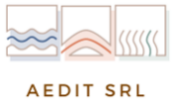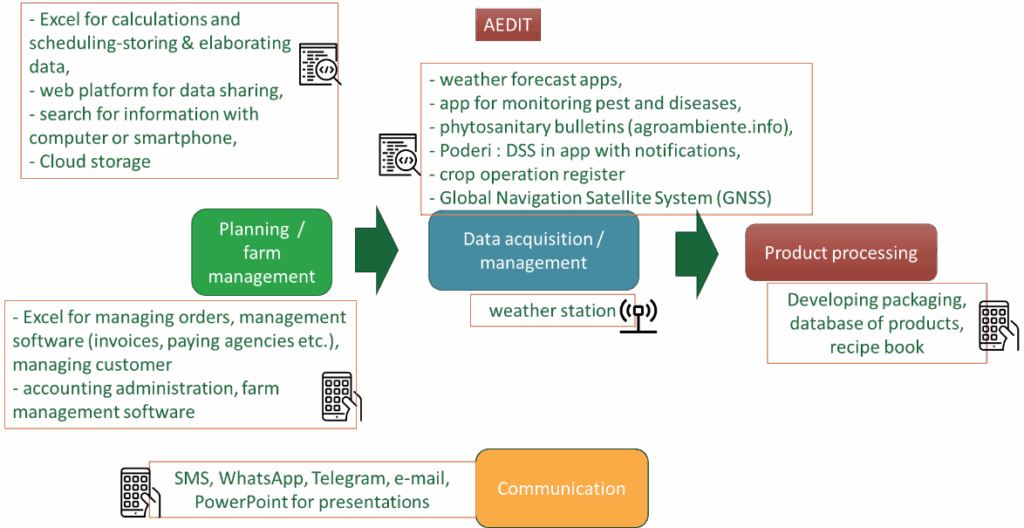Opportunities of Digital Tools for Agroecology in Olive Growing in Italy

Local context / Issue:
The main challenge for the farmers of the showcase (i.e., traditional olive groves) is to increase their competitiveness in the the market, which is negatively affected by a lack of innovation and generational turnover, and the low stability of production of olive groves over the years.
This could be improved with digitalisation and innovation transfer as ways to optimise agricultural practices and counteract the abandonment of land, especially promoting Integrated Pest Management practices.
The challenge is “How can the competitiveness of traditional olive groves (compared to more recent intensive olive plantations) be improved, and what methodology can be used to manage olive pests through Integrated Pest Management, in order to limit their abandonment?”
Showcase Outlook
Wheat ears, vineyards and olive trees stretch as far as the eyes can see. The essence of Italy reveals, in Tuscany, an unforgettable beauty. Romanticised by our cultural imaginary, this landscape expresses the myth of the Mediterranean heritage like no other place. However, not all Tuscany refers us to those iconic movies and books. Near Pisa, the picture hikes the hills of Monti Pisani surrounded by chestnut and pine trees. And it is here, on prominent dry-stone terraces, where the olive trees have watched the Tuscan plain for centuries.
The time seems to stand still. But the stillness and tranquillity cannot hide the challenges the olive oil sector is facing today. Here and everywhere. Fortunately, local olive growers do not give up. For what it means for them and their traditions but, above all, for what it represents for Tuscany. In economy, a turnover of almost 130 million euro.
In a competitive global market and an aggressive context caused by inflation and growing inputs costs, PATH2DEA has noted how these farmers are willing to enhance their competitiveness; how innovation can combat the lack of generational turnover and the worrying decline in production during recent years.
The fame of the olive oil born from the buttresses of Monti Pisani, recognized by the appellation IGP Toscano – sottozona Monti Pisani, is living under a threat. And digitalisation can be the answer to reverse this situation, optimising agricultural practices and counteracting the abandonment of land.
In front of the intensive olive plantations from the plain, farmers in Monti Pisani are looking for solutions to, first, ensure a regular productivity and, second, to add more value to their heroic farming. Because working all over the steep slopes, picking the olives by hand, making a cold-pressed oil in on-site mills, expressing the finest of Moraiolo, Leccino or Pendolino varieties, selling directly to the consumer, and fostering the local economy is all falling on their shoulders. And sometimes it can feel overwhelming.
Increasing the sustainability and the profitability of olive farming is, therefore, imperative. Their main concerns are improving farm management and monitoring pests and diseases. More answers are needed to tailor Decision Support Systems for small-scale olive farms. These are the challenges expressed in the PAT2DEA workshops.
Only by addressing and providing tangible solutions to these -to their- identified problems, Tuscany can safeguard the olive trees. And with them, the whole essence of Italy and the spirit of the Mediterranean.
Showcase at a glance
Showcase representative name: AEDIT S.R.L..
Challenge of the showcase: “Opportunities of digital tools for agroecology in olive growing”.
Type of production: Smallholder olive growers.
Type of agroecology: Low-input or organic.
Participants: First workshop: 20 participants – 6 organisers and 14 active participants, 6 women and 8 men. 10 farmers, 6 advisors, 2 researchers and 2 IT developers.
Second workshop: 28 participants – 7 organisers and 21 active participants, 8 women and 13 men. 9 farmers, 10 advisors, 3 technology providers, 5 researchers, 1 local authority.
Showcase representative: Iride Volpi.
Location: Monti Pisani, Italy
Website: https://www.aedit.it/

Testimonials
- Podcast with the showcase ambassador :
- Interview with an advisor:
Mapping of digital tools used in AEDIT’s showcase

A diversity of tools is used in the showcase, covering most of the range of existing digital technologies and supporting a diversity of operations on the farm. The picture illustrates the main tools for the main processes on the farm. More details about the tools are available in the Digital Tools section (link).
This showcase integrates transformation/packaging/final conditioning activities with small and local stakeholders or directly on the farm, for a high value of final products. Some digital tools are used to develop packaging & recipes books.
Usability/applicability of DTs: Main drivers, barriers, risks and trends

Drivers: #save & visualise data #reliability #time savingAs drivers that lead to DTs use, there are many mentions from all categories of participants of the opportunity they offer to access different years of data, having feedback, having notification/forecasting/advice/suggestions for organizing operations. Farmers see also a role in improving product quality (Decision Support Systems to optimize fertilization, irrigation and pest management). Some users may feel forced to use DTs in order not to be left behind: “I don’t have other choices” in the sense of fear of being left behind in a community of DT users. Participants particularly emphasize the importance of having advice in relation to local environmental & climatic conditions. To conclude about drivers, attendees from this showcase are aware of DTs benefits for all production processes. They mostly appreciate the possibility of working faster with these tools. They do not really mention what would guide their choice for one brand more than another.

Barriers: #complexity #unsuitable to system #lack of collaboration/knowledge #age Among the barriers towards digitalisation, there are barriers linked with the tool itself: (1) too complex; (2) low usability: not suited for all the challenges; (3) DSS not tailored for small olive farms. But the lack of digitalisation can be also connected to lack of knowledge about existing technologies: it reveals the importance of formation/training and communication with peers. On top of that, researchers deplore that farmers often don’t want to attend meetings that promote the use of DTs. This is the main take-out message from the workshop: creating a digital community would push farmers towards digitalisation, together with the establishment of a collaborative network for sharing data, knowledge and tools. Advisors see other barriers to usage like the age of farmers, connection problems, scare of sharing data (data privacy is seen as a risk for farmers too), difficulties in using them on the field. ICT developers regret the large amount of data having to be inserted in DSS and farmers & researchers agree that DTs can sometime lead to time wasting.

Risks: #control of workers #inaccuracyResearchers warn that DTs can lead to excessive control of workers, and that wrong interpretation may lead to wrong decisions. For example, site specific information is not generalizable; attention must be paid not to rely excessively on DTs or it may result in making misguided decisions.

Looking to the future/trends: #weather forecast #precise spraying #integrated data platform Regarding the need for new tools or associated practices, differences appear depending on the typology of participants:
• advisors see interest in DSS, weather stations, data archiving & analysis but also georeferencing/mapping information & production;
• farmers would like to use more tools to communicate, access to big data & optimise post-harvest;
• researchers put forwards the use of drones for precise pest management.
• DTs to improve the management of product quality (on-farm or local processing and sale on farm or in short supply chain).
The added value of the used digital tools and technologies
When grouped according to specific management activities, digital tools and technologies become key enablers of the agroecological transition. Their combined use supports more resilient and sustainable farming practices. Explore how digital tools and technologies enhance this showcase management—step through the timeline of its core activities.
More details about the tools are available in the Digital Tools section (link).
Olive production
What do farmers from this showcase expect as improvement or new function for digital tools to enhance their transition to more agroecological practices?
In the showcase region, olive producers are involved in a short distribution chain, consisting primarily of themselves and the local oil mill. This structure enables them to provide many examples of potential improvement for tools all along the production and downstream chain.
Producers expressed a clear interest in enhanced farm management applications, emphasizing the need for greater integration between tools, more actionable notifications, improved interoperability with existing systems (e.g., farm notebook and national agricultural information systems), enhanced management and traceability capabilities.
They also suggested the use of QR codes for oil traceability, allowing consumers to access detailed information about the olive farm and oil characteristics, and blockchain platforms for verification and traceability.
Participants emphasised that digital tools should facilitate work and data exchange, rather than replace the agronomist, whose expertise remains highly valued. Some tools are currently underutilized due to high costs, however the rising demand will make advanced technologies more accessible in the future. Examples include autonomous tools for data collection (e.g., drones or automatic pest traps).
Overall, the showcase participants see digital tools as having a key role in supporting the agroecological transition, including considerations related to climate change, and recognise their potential to improve sustainability, efficiency, and traceability throughout the olive oil value chain.
More details on the gaps found in the 6 showcases can be explored in the Gap Analysis section (link).

